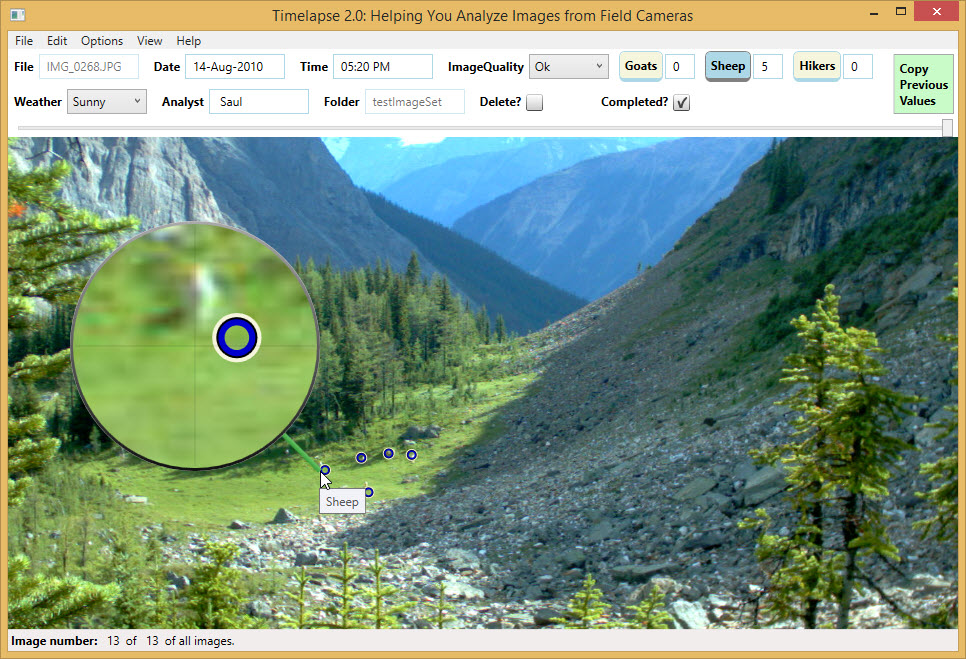Timelapse: An Image Analyser for Camera Traps

Field cameras (also called camera traps) capture images (and sometimes videos) of strategic field locations at regular intervals or when any motion is detected. After retrieving the camera's images, scientists visually examine each image and video and count/describe the entities and conditions of interest (e.g., people, wildlife, weather).
The problem is that visually analyzing and encoding data from thousands to millions of images and videos is a painful process.
Timelapse Image Analyser helps scientists do this last visual analysis and encoding step. In brief, the tool:
- reads and displays images and videos from any type of remote camera (as long as they are numbered)
- automatically extracts information from all images such as dates, times and location
- extracts metadata information of your choosing, if its available in the images
- categorizes unusual images including dark (night time) and corrupted ones
- displays a custom interface for entering data specific to the scientist's project, where the biologist can enter data by typing, by selecting from a list of choices, and (for counting) by clicking on objects in the image
- supports visual search through a magnifying glass, through pan and zooming (where switching images will keep the same pan/zoom levels), and through several image enhancement methods
- saves all data to a file that can be opened in Excel and later imported into a database of your choice
- allows you to examine subset of your images where you apply searches specific to your data
- can import, display and query image recognition data as produced by Microsoft Megadetector
- and much more...
Getting started is fairly simple
- Download the The Timelapse QuickStart Guide. Also watch its Video companion.
- Download and unzip the Practice Image Set [~476mb zip file] to a location on your computer, where you can now try out the steps on the sample camera trap files as described in the Quick Start Guide.
- Try out Timelapse on your own images. To create your own template of relevant data fields, seeThe Timelapse Template Guide and watch its companion video.
- Continuing on: After you have mastered the basic Timelapse features, take a look at The Timelapse Reference Guide to see other features of Timelapse that will likely be useful. You may also want to look at The Timelapse Image Recognition Guide to see if image recognition is of value to you.
Further readings
- Greenberg, S. (2019) Pity the analyst: Designing software for image inspection. In Remote Cameras Workshop. (Held at Canmore Nordic Centre, Canmore, AB. Sponsored by Innovis, AB), Presentation: 35 slides with embedded video, March 25. This slide deck includes videos of various Timelapse features
- Greenberg, S., Godin, T. and Whittington, J. (2019) User Interface Design Patterns for Wildlife-Related Camera Trap Image Analysis. Ecology and Evolution, Vol. 9 Issue 24:13706-13730. Wiley, December 2 Describes the major design ideas behind Timelapse features
- Greenberg, S. (2020) Automated Image Recognition for Wildlife Camera Traps: Making it Work for You. Research report, University of Calgary: Prism Digital Repository, August 21, 15 pages, See also video presentation
- You have likely heard about or read articles that apply automated image recognition to wildlife camera trap images. The basic idea is that the image recognition system will automatically analyze your images to locate and classify the wildlife species within them. But before you jump on the bandwagon, here are a few things you should know about.
- Greenberg, S. and Godin, T. (2015) A Tool Supporting the Extraction of Angling Effort Data from Remote Camera Image (Feature Article). Fisheries Magazine, 40(6):276-287. American Fisheries Society, June. Describes an earlier version of Timelapse as use by fisheries biologists. Ask me for a copy.
Independent articles concerning gaines in efficiency when using Timelapse and Megadetector
- Morton, J. (2023) Refuge Notebook: New technology increases efficiency of refuge cameras. Peninsula Clarion, April 6.
- Fennell, M., Beirne, C. and Burton, C. (2022) Use of object detection in camera trap image identification: assessing a method to rapidly and accurately classify human and animal detections for research and application in recreation ecology. Global Ecology and Conservation, 35, June.
Timelapse Image Analyzer was created by Saul Greenberg, a University of Calgary, Computer Science professor, and is supported by Greenberg Consulting Inc.
Contact Saul Greenberg for feature requests, bug reports, and general feedback.
Acknowledgements and attributions. Many Timelapse users provided feedback on how to improve Timelapse - they really helped inform the system design. Micah Bresette, Ryan Bane, and Todd West contributed to upgrading the Timelapse code base. Timelapse incorporates various components that others have produced and made freely available: they deserve special thanks. See the Timelapse License page, which contains a list of these components and where they are from.
273859:59104